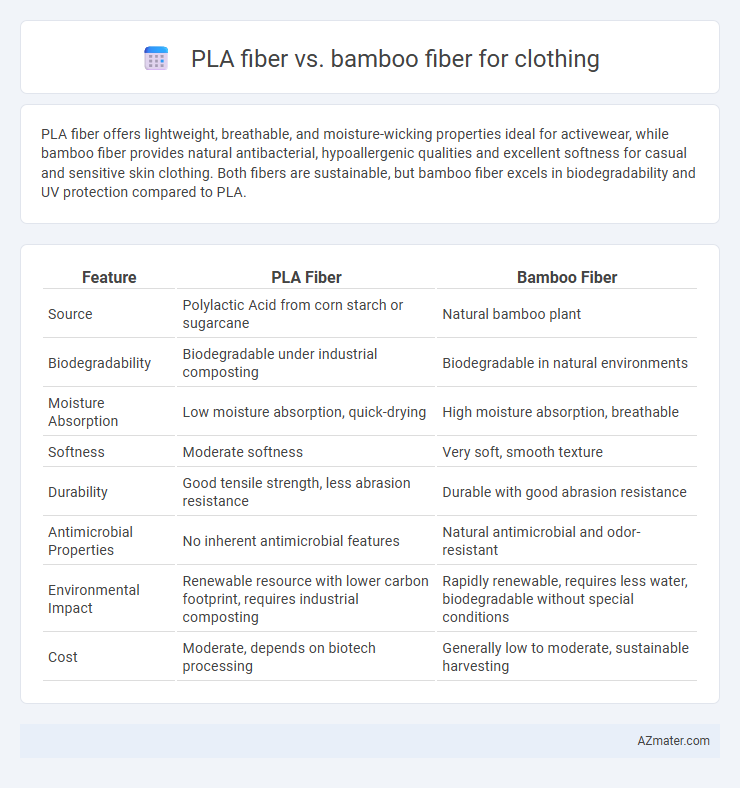PLA fiber offers lightweight, breathable, and moisture-wicking properties ideal for activewear, while bamboo fiber provides natural antibacterial, hypoallergenic qualities and excellent softness for casual and sensitive skin clothing. Both fibers are sustainable, but bamboo fiber excels in biodegradability and UV protection compared to PLA.
Table of Comparison
| Feature | PLA Fiber | Bamboo Fiber |
|---|---|---|
| Source | Polylactic Acid from corn starch or sugarcane | Natural bamboo plant |
| Biodegradability | Biodegradable under industrial composting | Biodegradable in natural environments |
| Moisture Absorption | Low moisture absorption, quick-drying | High moisture absorption, breathable |
| Softness | Moderate softness | Very soft, smooth texture |
| Durability | Good tensile strength, less abrasion resistance | Durable with good abrasion resistance |
| Antimicrobial Properties | No inherent antimicrobial features | Natural antimicrobial and odor-resistant |
| Environmental Impact | Renewable resource with lower carbon footprint, requires industrial composting | Rapidly renewable, requires less water, biodegradable without special conditions |
| Cost | Moderate, depends on biotech processing | Generally low to moderate, sustainable harvesting |
Introduction to PLA and Bamboo Fibers
PLA fiber, derived from renewable resources like corn starch, offers biodegradable and eco-friendly textile options with moisture-wicking properties suitable for activewear. Bamboo fiber, made from bamboo pulp, is naturally antimicrobial, breathable, and biodegradable, providing softness and durability in clothing applications. Both fibers contribute to sustainable fashion by reducing reliance on synthetic materials and lowering environmental impact through renewable sourcing and biodegradability.
Origin and Production Processes
PLA fiber, derived from renewable resources like corn starch or sugarcane, undergoes a fermentation process to produce polylactic acid, which is then spun into fibers suitable for clothing. Bamboo fiber originates from bamboo plants, extracted through either a mechanical process that crushes the stalks to separate the fibers or a chemical process involving solvents to create bamboo viscose or rayon. The production of PLA fiber emphasizes biodegradable properties and sustainability in industrial polymerization, whereas bamboo fiber combines natural cellulose extraction with either eco-friendly mechanical or chemical processing methods, impacting its eco-profile and texture in textile applications.
Environmental Impact of PLA vs Bamboo Fiber
PLA fiber, derived from renewable resources like corn starch, offers biodegradability but requires industrial composting facilities and energy-intensive processing, which may generate greenhouse gases. Bamboo fiber, produced from fast-growing bamboo plants, boasts natural biodegradability and demands minimal pesticides and water, significantly reducing its environmental footprint. While bamboo fiber's mechanical processing is more eco-friendly than chemical methods, sustainable sourcing and production remain crucial for minimizing deforestation and habitat loss.
Physical Properties Comparison
PLA fiber exhibits high tensile strength and excellent moisture-wicking capabilities, making it durable and comfortable for active wear. Bamboo fiber offers superior softness and natural antimicrobial properties, enhancing fabric breathability and odor resistance. Both fibers have good UV protection, but PLA fiber tends to have better thermal resistance and quicker drying times than bamboo fiber.
Comfort and Breathability
PLA fiber offers excellent moisture-wicking properties and a soft texture, making it comfortable for activewear. Bamboo fiber is highly breathable and naturally antibacterial, enhancing comfort by reducing odor and skin irritation. Both fibers excel in breathability, but bamboo's thermal regulation makes it ideal for varied climates.
Durability and Longevity in Clothing
PLA fiber offers high tensile strength and resistance to abrasion, contributing to its durability in clothing applications, though it can be sensitive to high heat and prolonged moisture exposure. Bamboo fiber is naturally resilient with antimicrobial properties, providing softness and enhanced longevity, but it may weaken faster under repeated washing and intense mechanical stress. Both fibers balance eco-friendliness with varying durability profiles; PLA suits garments requiring structural integrity, while bamboo excels in comfort with moderate wear resistance.
Dyeability and Fabric Aesthetics
PLA fiber exhibits excellent dyeability due to its polyester-like molecular structure, allowing vibrant and long-lasting color absorption, making it suitable for bright, vivid clothing designs. Bamboo fiber, derived from natural cellulose, offers a soft, silky texture with a natural sheen but demonstrates lower dye affinity, often requiring pre-treatment for colorfastness and uniformity. Fabrics made from PLA fiber tend to have a smooth, synthetic feel with a consistent finish, while bamboo fiber clothes provide a breathable, eco-friendly option with a natural, matte aesthetic enhancing comfort and style.
Biodegradability and End-of-Life Disposal
PLA fiber, derived from renewable resources like corn starch, is biodegradable under industrial composting conditions but may persist in natural environments due to its specific degradation requirements. Bamboo fiber, often processed chemically into rayon or viscose, loses its natural biodegradability properties and behaves like synthetic fibers in disposal, although mechanically processed bamboo fabric remains more eco-friendly and biodegradable. Choosing bamboo fiber mechanically processed ensures better end-of-life biodegradability compared to PLA, which depends heavily on industrial composting facilities for effective disposal.
Cost and Availability in the Market
PLA fiber offers a cost-effective solution with widely available production from renewable corn starch, making it increasingly popular in apparel manufacturing due to its affordability. Bamboo fiber, while eco-friendly and naturally breathable, tends to be more expensive due to intensive processing methods and limited large-scale cultivation. Market availability of PLA fiber is expanding quickly with advancements in bioplastics, whereas bamboo fiber supply remains relatively niche and region-specific, affecting its overall accessibility in clothing production.
Conclusion: Which Fiber is Better for Clothing?
PLA fiber offers superior moisture-wicking and biodegradability, making it ideal for activewear and sustainable fashion. Bamboo fiber excels in softness and natural antibacterial properties, providing comfort and odor resistance for everyday wear. Choosing between PLA and bamboo fibers depends on prioritizing performance benefits or comfort features in clothing applications.

Infographic: PLA fiber vs Bamboo fiber for Clothing
 azmater.com
azmater.com